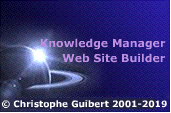|
Tree :
Faceted index, by topics :
Menu
"Main" tree view (1) "Normal" view (15) Display (4) Edit (9) File (52) Help (7) Ideas (57) Import/Export (16) Keywords (6) Publications (19) Tasks (1) Templates (72) Windows (1)
Feature
Category
How to insert these widgets? |
 The easiest and most efficient method to add content to an idea is to copy this content from another source, and then to paste it in the current idea. Content source can be :
In all cases, WIT tries to keep the text formatting (styles, tables, images...), according to the Windows Clipboard contents (this depends on the chosen content source). It is possible that you are not satisfied with the resulting formatting : either "too much" or "not enough" formatted. There are two possible paste methods:
This information capture process can also be automated, including idea creation, with the auto import function. Specific case of images included in Web pages. When HTML content is involved, WIT also imports the embedded images in the text that is pasted into the idea :
If you do not use Microsoft Internet Explorer, this process may require a longer time (image are then dowloaded instead of being retrieved from the cache). Note : some images may not be imported when their URLs are too complex (dynamically evaluated URL, request or JavaScript). Version 5.71:
Specific case of images or images fragments, copied from an image editing software (Paint Shop Pro, Photoshop...)WIT converts the image or image fragment from the Windows Clipboard into a PNG image file that is placed in the "wit-imported-images" subfolder, and establishes the link to this image. Specific case of JavaScript code included in the pasted fragment. In the WYSIWYG editor, WIT cleans any JavaScript code that may be included in the pasted HTML fragments in order to prevent JavaScript errors. If you wish to keep JavaScript code and have WIT automatically gather JavaScript dependencies (typically page local variables and functions declarations), you have to paste the fragment in the "Page Preview" view (see Intelligent information paste into ideas ). See also :
Keywords : Images ; JavaScript ; Paste ; Paste text
|
||||||||||||

